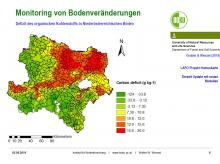Soil Monitoring Lower Austria
Soil Condition Inventory
At the beginning of the 1990s, a soil condition inventory was carried out for the first time in Lower Austria to record general soil parameters at a total of about 1450 sites. Since, based on the relevant scientific literature, it can be assumed for most of the soil properties recorded in the BZI that changes only occur gradually over long periods of time and can thus be statistically validated, a re-sampling was planned for longer time intervals. This started after 30 years at the beginning of 2020. Currently, topsoil samples are resampled at 300 locations in the Pannonian region (Chernosem region) and examined for the characteristic values of organic carbon, nitrogen, selected metals and metalloids. The evaluation opens up the possibility to identify changes in the investigated parameters over the last 30 years.
Repeat sampling of soil mapping sites in Lower Austria
In the period 2016-2019 >600 profile points of the Austrian soil mapping in Lower Austria were sampled again. Top soil samples were taken from cropland and grassland locations for which archive samples from the initial sampling are still available. The investigations include soil acidity (pH-value), carbonate, organic carbon and nitrogen, as well as nutrients that are potentially available to plants (phosphorus, potassium and silicon).
Mapping and modelling of carbon saturation potentials and deficits
Based on the BZI Lower Austria, the saturation potentials were derived from the grain fraction <20 µm (clay, fine and coarse silt) using model calculations and GIS-based interpolation for the whole of Lower Austria with the help of a landscape model in high resolution. Furthermore, the saturation deficits were calculated from the difference to the organic carbon contents collected in 1990 and also converted into a high-resolution map by means of a landscape model.
Soil monitoring and monitoring of organic pollutants in Lower Austrian soils
In the central settlement and economic areas of Schwechat and Tullner Feld, a total of >50 soil monitoring plots have been set up since the end of the 1990s according to the concept of Blum et al. (1996), some of which have been sampled several times. The measured parameters include pH values, organic carbon and carbonate as well as inorganic (heavy metals and metalloids, fluorine) and organic (PAH, dioxins and furans, BTEX, PCB) pollutants. As part of the Austro-PoPs project, some of the areas were sampled again in 2019.
26.09.2024
555 x Paradies-Genüsse - Obstvielfalt entdecken und schmecken
more ...24.+25.09.2024
31th Conferece of the Danube Region
more ...21.09.2024
Fest der Obstvielfalt im Alchemistenpark
more ...13.-15.09.2024
Mein Beeren- und Obstparadies
more ...11.-13.09.2024
Tropentag 2024
more ...06.-09.2024
ernte.dank.festival. am Wiener Heldenplatz
more ...15.+16.05.2024
Bodenforum Österreich - Frühjahrstreffen 2024
more ...20.-21.04.2024
Joel Salatin - Masterclass-Seminar Weidemanagement
more ...16.04.2024
Exkursion Mehrnutzungshecken
more ...12.04.2024
Dialog Zukunft Pflanzenbau: Runder Tisch - EU Richtlinie zur Bodenüberwachung und -resilienz
more ...12.04.2024
Online-Workshop Boden und Klima - Ganzheitliches Wassermanagement in Stadt und Land
more ...03.04., 04.04., 23.04.2024
Flexibles Begrünungsmanagement im Wein- und Obstbau
more ...27.-29.03.2024
Mein Beeren- und Obstparadies
more ...20.03., 21.03., 03.04., 04.04., 23.04.2024
Flexibles Begrünungsmanagement im Wein- und Obstbau
more ...20.03.2024
Obstbaumschnittkurs für langlebige und gesunde Bäume "Stummelschnitt ade"
more ...12.-14.03.2024
Vortrag: "Die Essbare Stadt, Geeignete Obstbaumarten für den Urbanen Raum"
more ...13.03.2024
Carbon Farming, wofür und für wen? - Hybridveranstaltung
more ...12.03.2024
Zertifikatslehrgang Bodenpraktiker Ackerbau 2024
more ...09.03.2024
Stummelschnitt ade - Obstbaumschnittkurs für langlebige und gesunde Obstbäume
more ...05.03.2024
Exkursion Mehrnutzungshecken
more ...



